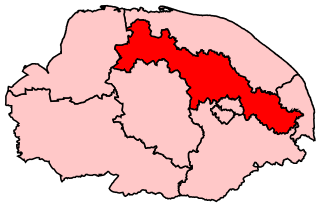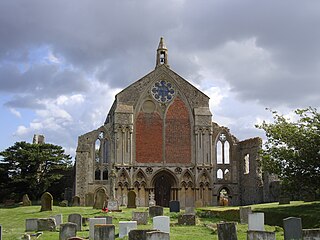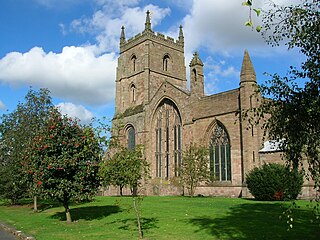
Walsingham Friary was a Franciscan friary at Walsingham, Norfolk, England. It was founded in 1347 and suppressed in the 16th century in the Dissolution of the Monasteries.

Walsingham Friary was a Franciscan friary at Walsingham, Norfolk, England. It was founded in 1347 and suppressed in the 16th century in the Dissolution of the Monasteries.

Walsingham is a village in North Norfolk, England, famous for its religious shrines in honour of the Virgin Mary. It also contains the ruins of two medieval monastic houses. Walsingham is 27 miles (43 km) northwest of Norwich.

The Wells and Walsingham Light Railway is a 10 1⁄4 in gauge heritage railway in Norfolk, England running between the coastal town of Wells-next-the-Sea and the inland village of Walsingham. The railway occupies a four-mile section of the trackbed of the former Wymondham to Wells branch which was closed to passengers in stages from 1964 to 1969 as part of the Beeching cuts. Other parts of this line, further south, have also been preserved by the Mid-Norfolk Railway.

East Barsham Manor is an important work of Tudor architecture, a leading and early example of a prodigy house, originally built in the 1520s. It is located in the village of East Barsham, about 2.5 miles (4.1 km) north of the town of Fakenham and 2.1 miles (3.4 km) south west of the village of Walsingham in the English county of Norfolk. It is protected as a Grade I listed building.

Broadland is a Norfolk constituency, which has been represented in parliament since the 2019 general election by Jerome Mayhew, a Conservative.

Thetford Priory is a Cluniac monastic house in Thetford, Norfolk, England. It should not be confused with the Dominican Friary of Blackfriars, Thetford that later became part of Thetford Grammar School.

St Mary's Priory, Binham, or Binham Priory, is a ruined Benedictine priory located in the village of Binham in the English county of Norfolk. Today the nave of the much larger priory church has become the Church of St. Mary and the Holy Cross and is still used as a place of worship. The remains of the priory are in the care of English Heritage. The abbey's west face is the first example in England of gothic bar tracery, predating Westminster Abbey by a decade.

Walsingham Priory was a monastery of Augustinian Canons regular in Walsingham, Norfolk, England seized by the crown at the Dissolution of the Monasteries under King Henry VIII.

St. Andrew's Hall and Blackfriars' Hall are a Grade I listed set of friary church and convent buildings in the English city of Norwich, Norfolk, dating back to the 14th century. They make up the most complete friary complex surviving in England. The complex is made up of several flint buildings. The centrepiece is St Andrew's Hall. The halls are now used for conferences, weddings, concerts, beer festivals and meetings. The maximum capacity is 1200 people. It is one of the Norwich 12 heritage sites.

The Priory Church is an Anglican parish church in Leominster, Herefordshire, England, dedicated to Saint Peter and Saint Paul. The building was constructed for a Benedictine Priory in about the 13th century, although there had been an Anglo-Saxon monastery in Leominster, possibly on the same site. In 1539 the east end of the church was destroyed along with most of the monastic buildings, but the main body of the church was preserved.

Walsingham Rural District was a rural district in the county of Norfolk, England. It was created in 1894. On 1 April 1935 it was enlarged by the addition of the parishes of Hindolveston, Thurning, Wood Norton and Briston. On 1 April 1974 it was abolished under the Local Government Act 1972, and has since formed part of the District of North Norfolk.
Barham Friary was a friary in Linton, Cambridgeshire, England. It was established around 1272 and was dissolved in 1539.
Austin Friary, Cambridge was a priory in Cambridgeshire, England. It was established in 1092 and in 1112 became part of Barnwell Priory. The priory was located at Peas Hill in central Cambridge.

Greyfriars, Stamford was a Franciscan friary in Lincolnshire, England. It was one of several religious houses in Stamford suppressed in the Dissolution of the Monasteries.

Boston Friary refers to any one of four friaries that existed in Boston, Lincolnshire, England.

Burnham Norton Friary was a Carmelite friary near Burnham Market in Norfolk, England. It is now a ruin.
Scadbury Park is a Local Nature Reserve in Chislehurst in the London Borough of Bromley. It is also a Site of Metropolitan Importance for Nature Conservation. It is over 300 acres, and is part of an extensive wildlife corridor together with Petts Wood and the Jubilee Country Park.

Lichfield Clock Tower or Friary Clock Tower is a 19th-century Grade II listed clock tower located on 'The Friary' south of Festival Gardens in the city of Lichfield, Staffordshire in the United Kingdom.
Beck Hall, Bec Hall or Bek Hall is a grade II listed 18th-century farmhouse in Billingford, Breckland, Norfolk, England. It is believed to be on the site of a former "hospital" or "hospice" adjacent to the Chapel of St Paul. The hospital was founded by William of Bec : records go back before 1224. The hospital was dedicated to St Thomas of Canterbury. An early resident of Bec was Alanus Elfwold (1248).

The Anglican Shrine of Our Lady of Walsingham is a Church of England shrine church built in 1938 in Walsingham, Norfolk, England. Walsingham is the site of the reputed Marian apparitions to Richeldis de Faverches in 1061. The Virgin Mary is therefore venerated at the site with the title of Our Lady of Walsingham.
Coordinates: 52°53′32″N0°52′19″E / 52.8921°N 0.8720°E
| This article about a Norfolk building or structure is a stub. You can help Wikipedia by expanding it. |
| This article about a British Christian monastery, abbey, priory or other religious house is a stub. You can help Wikipedia by expanding it. |